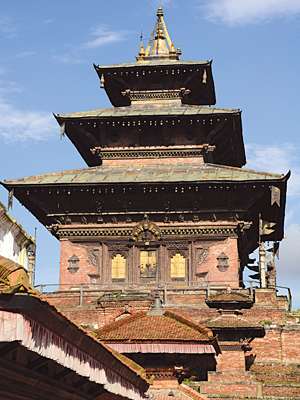Those in search of a Taleju Temple inside the Kathmandu Valley are in luck, for there are not one, not two, but three Taleju Temples here. The first is located in Kathmandu Durbar Square, the second in Bhaktapur and the third in Patan Durbar Square. The three large Taleju Temples are named after and dedicated to Goddess Taleju Bhawani, a sacred deity who has four heads and ten arms. Golden statues and metal work depicting the ten-armed Goddess can be found in various locations around the three Taleju Temples. Inside the temples are shrines to both Taleju Bhawani and the Kumari, Nepal’s Living Goddess. Taleju Bhawani was the clan Goddess of the Malla kings, who ruled Nepal from the 12th to the 18th century, which explains the existence of a Taleju Temple in each of the valley’s three main city centers.

The Taleju Bhawani Temple of Kathmandu stands out distincty among the many other temples and monuments that dot the Kathmandu Durbar Square
On a tour of the three temples, Bhaktapur is, perhaps, the place to begin, for the city’s Taleju Temple, housed in the vicinity of Bhaktapur Durbar Square, is the oldest of the lot. Bhaktapur’s Taleju Temple is located in Mulchok Court near the Golden Gate. Traditionally, this Taleju Temple was only open to the reigning kings, but is now open to all Hindus as well. Others can visit the temple, but non-Hindus are not allowed inside. On your visit, pay special attention to the beautifully sculpted archways and window frames, which reveal a fine attention to detail from centuries past.
The second Taleju Temple within the valley is located in the center courtyard of Patan Durbar Square. Patan’s Taleju Temple was built in 1667 during the reign of King Shree Niwas Malla. Across from Patan’s Taleju Temple is the Taleju Bell. According to EnjoyNepal travel guide, the Taleju Bell was installed in 1736 by King Vishnu Malla so that petitioners could alert him when they had filed a grievance or complaint.
The third (and main) Taleju Temple within the valley is located in Kathmandu Durbar Square in Trishul Chowk, which is attached to the Hanuman Dhoka Palace. Perhaps the most visited of the three structures, Kathmandu’s Taleju Temple was constructed in 1564 by King Mahendra Malla. There is much lore and mysticism surrounding the beginnings of Kathmandu city’s Taleju Temple. It is said that the temple was built in the shape of a yantra, a mystical diagram said to have magical powers, due to a suggestion that came straight from the mouth of Goddess Taleju herself. According to the South Asian Association for Regional Cooperation, Taleju Bhawani made a special appearance at the temple’s dedication ceremony. Legend has it that Goddess Taleju Bhawani showed up undercover, disguised as a bee.
A tour of the three Taleju Temples combines a number of appealing aspects of exploring the Kathmandu Valley: Hindu religion, architectural grandeur, ancient legends and Malla-era history. Stop by one of the Taleju Temples, or all three to compare and contrast the grandiose wonders of the centuries-old structures.









